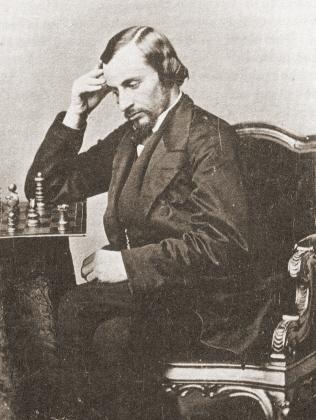
Edward Winter

Daniel Harrwitz
Bernhard Horwitz and George Perigal – Daniel Harrwitz
(blindfold)
London, 1846 or 1847
(Remove White’s queen’s rook.)
1 e4 e5 2 Bc4 Nf6 3 Nf3 Nc6 4 Ng5 d5 5 exd5 Na5 6 Bb5+ Bd7 7 Qe2 Bd6 8 Bxd7+ Qxd7 9 c4 b6 10 Nc3 O-O 11 O-O Nb7 12 d3 Rae8 13 Kh1 h6 14 Nh3 Qg4 15 f3 Qh5 16 Nb5 e4 17 Qd1 exf3 18 Rxf3 Re7 19 Bd2 Ng4 20 Nxd6 Nxd6 21 Qg1 Rfe8 22 Nf4 Qh4 23 g3 Qf6 24 Bc3 Qf5 25 h3 Ne5 26 Qd4 f6 27 Rf2 h5 28 Kg2 Ndf7 29 b4 Ng5 30 c5 Nef3 31 Qc4 Ne1+ 32 Bxe1 Rxe1 33 d6+ Kh7 34 h4 Ne6 35 Nd5 Qg4 36 Qxg4 hxg4 37 d7 Rd8 38 c6 Re5 39 Nc3 Nd4 40 b5 Nxb5 41 Nxb5 Rxb5 42 d4 Kg6 43 Re2 Kf7 44 Kf2 Rf5+ 45 Ke3 Rd5 46 Kd3 Rd6 47 Rc2 Rf8 48 Ke4 Ke6 49 Re2 f5+ 50 Kd3+ Kf7 51 Rc2 Ke7 52 a4 Rff6 53 Re2 Rde6 54 Rxe6+ Rxe6 55 d5 Rd6 56 Kd4 g6
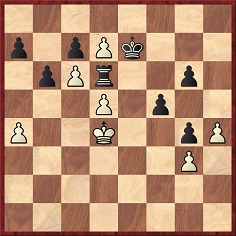
57 Ke5 a6 58 Kd4 b5 59 axb5 axb5 60 Ke5 b4 61 Kd4 Rxd5+ 62 Kxd5 b3 63 Ke5 b2 64 Kf4 b1(Q) 65 Kg5 Qe4 66 h5 gxh5 67 Kxh5 Qxc6 68 Kg5 Qxd7 69 Kg6 Qe6+ 70 Kg5 Kf7 71 Kf4 Kg7 72 Kg5 Qe4 73 Kh5 Kf6 74 K moves Qh1 mate.
Source: Chess Player’s Chronicle, 30 January 1847, pages 33-34. Staunton’s magazine commented: ‘It is not often, over the chess board even, that anything finer or truer is seen than the play of Black throughout this game. When one looks at the precision of these latter moves, and remembers under what circumstances they were played, the whole thing becomes a marvel, as curious as it is inexplicable.’ The game lasted five hours.
(2153)
Page 395 of Kings, Commoners and Knaves quoted Staunton in the Chess Player's Chronicle, 13 February 1847, page 49:
‘Mr Harrwitz sees everything without the board as well as most players with one.’
From Luca D’Ambrosio (Bolzano, Italy):
‘Standard reference works, such as Gaige’s Chess Personalia (page 163) and Chicco and Porreca’s Dizionario enciclopedico degli scacchi (page 266), give 9 January 1884 and Bolzano/Bozen as the date and place of Daniel Harrwitz’s death.
In July 2009 I checked the Totenbuch Number 12, 1884-1895 (Dompfarre M. Himmelfahrt, Bozen), page 1. It reported that Harrwitz died at 5 a.m. on 2 January 1884, at the age of 63, the cause of death being “lung paralysis” (“Lungenlähmung”). Under “Religion” it was stated “Israelit”, and his last address was “Zollstange 173” in Bolzano.
Following on from this information, I managed to find Harrwitz’s grave in the Jewish Cemetery in Bolzano. My photographs were taken on 17 July 2009, with the kind permission of the Jewish Community of Meran/Merano.
The gravestone has the following inscription:
“Hier ruhet
unser guter Bruder u. Onkel
Professor
D. Harrwitz
geb. in Breslau d. 22.2.1821
gest. in Bozen d. 2.1.1884.”
The death-date on the gravestone is the same as that given in the Totenbuch. Any remaining doubts about its correctness are removed by verification of what was published on page 4 of the Bozner Zeitung of 4 January 1884:
“Verstorbene im Bezirke Bozen.
(...)
2. Jänner. Dr. Harwitz [sic], led. Professor aus Breslau, 63 J. alt, an Lungenlähmung.”It is therefore certain that his widely-reported date of death, 9 January 1884, is wrong.
Now I turn to his date of birth. The Totenbuch and the gravestone are significantly at variance with the information commonly given in such works as those by Gaige and Chicco/Porreca referred to above, i.e. 29 April 1823, in Breslau. The day, month and year are all different from what appears on the gravestone (22 February 1821). If the gravestone and the Totenbuch are correct, Harrwitz was born over two years earlier than was previously believed, and he died at the age of nearly 63.
The inscription on the gravestone indicates that Harrwitz was survived by relatives (“unser guter Bruder und Onkel”), which to me is a strong argument in favour of the correctness of the gravestone date.
It would be interesting to know whether any documentation in Breslau/Wrocław (Poland) confirms the birth-date on the gravestone.
For assistance with my research I should like to thank Pater Plazidus (Benediktinerkloster Muri-Gries, Bolzano/Bozen), Mrs Streiter (Dompfarre Maria Himmelfahrt, Bolzano/Bozen) and the Jewish Community of Merano/Meran.’
(6286)
Ulrich Schimke (Cologne, Germany) writes:
‘I can confirm the conclusion of Luca D’Ambrosio in C.N. 6286 that Daniel Harrwitz was born on 22 February 1821, and not, as had previously been believed, on 29 April 1823.
Volumes on the birth of Breslau Jews can be consulted at the FamilySearch website. The film that I used is “Geburten 1804-1802, 1809-1822, 1825-1846 International Film 1184380 7989998”. (The parts from 1809-1822 were transcripts dating from 1933 for the Breslau Jewish Congregation; see the entry “PSR A022 Breslau, Schlesien Geburtsregister 1818-1822 Nach dem im Breslauer Polizeipräsidium befindlichen jüdischen Geburtsregistern, abgeschrieben für das Archiv der Synagogengemeinde Breslau im Jahre 1933” from the inventory of the Jewish Museum in Frankfurt.)
The entry 17/1821 of the original page 60 of the transcript [page 337/594 of the film] states that Daniel, the son of Israel Harrwitz and Beate Harrwitz (née Friedländer) was born on 22 February 1821:
He had several brothers and sisters, and the entries for two of them, Julius and Wilhelmine, provide an example of the information available concerning their parents.
3 October 1819: entry for Julius 127/1819, on page 33 of the transcript (page 358/594 of the film):
31 October 1822: entry for Wilhelmine 101/1822, on page 87 of the transcript (page 383/594 of the film):
The profession of Israel Harrwitz, Daniel’s father, is not always readable. One of the links below contains a merchant register from Breslau, where his business was recorded as “Tabak und Cigarrenhandlung und Lotterie-Collekte”, whereas in the Daniel Harrwitz entry it reads “[?]warenhdl”. The entry for Julius Harrwitz has the reference “Schn- w- hndl”.
Further information about Daniel’s brother Julius, who became a publisher in Berlin, is available on a Deutscher Schachbund page. See too the Stolpersteine in Berlin page for information about Maximilian Harrwitz, who was Julius’ son and thus Daniel’s nephew.’
(11618)
A comment received from Michael Lorenz (Vienna) on 21 December 2019:
‘The profession of Harrwitz’s father, “Schn. w. hndl”, given near the end of C.N. 11618, is “Schnittwarenhändler” (i.e. vendor of cloth or drapery). The word also appears in the entry concerning Daniel Harrwitz’s birth.’
Jean-Pierre Rhéaume (Montreal, Canada) notes the poor quality of the Harrwitz entry on pages 177-178 of the Dictionnaire des échecs by François Le Lionnais and Ernst Maget (Paris, 1967):
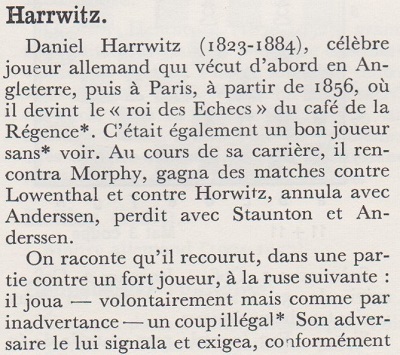
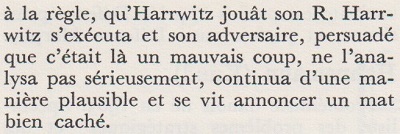
Half of the entry (‘On raconte ...’) is given over to an anecdote. (See Chess Cunning, Gamesmanship and Skulduggery.)
One of the few detailed obituaries of Harrwitz was by William Wayte on pages 136-139 of the April 1884 BCM:
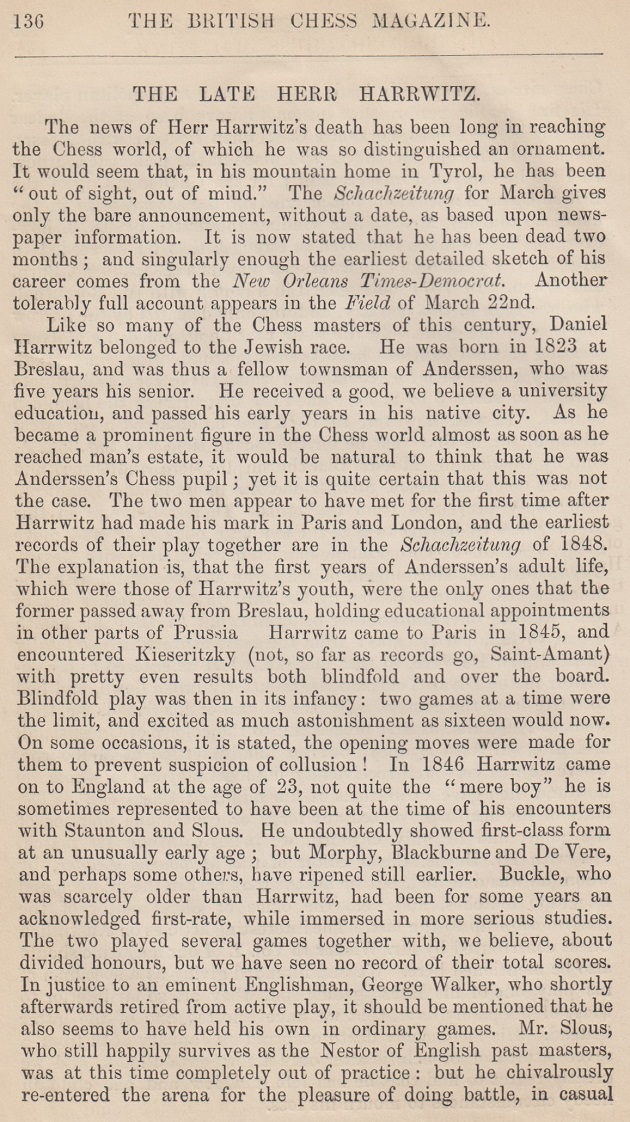
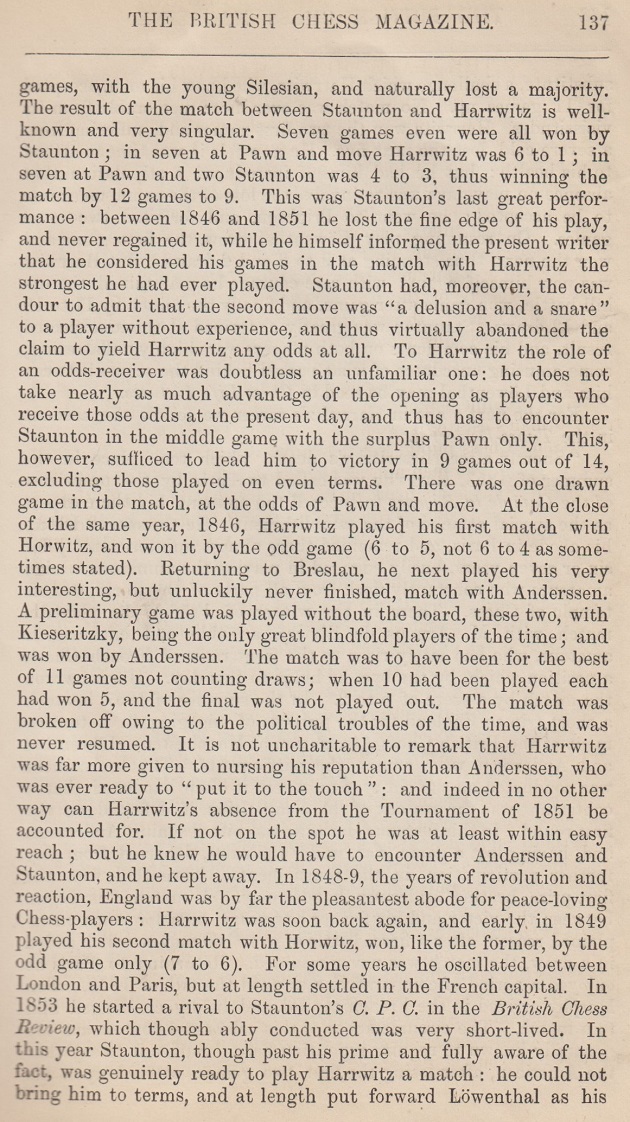
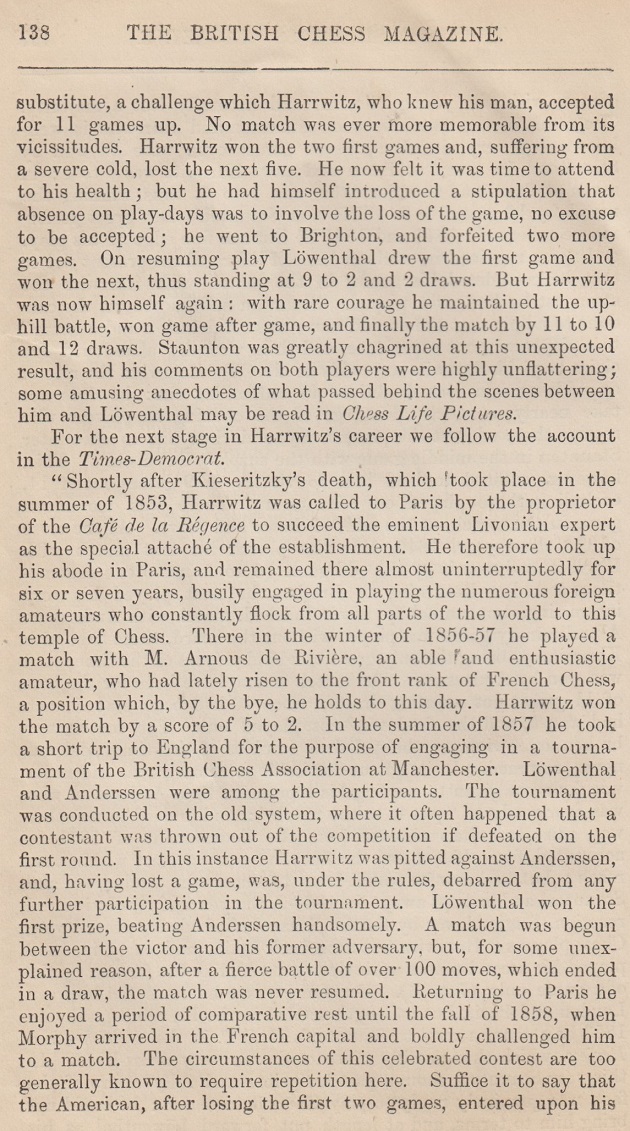
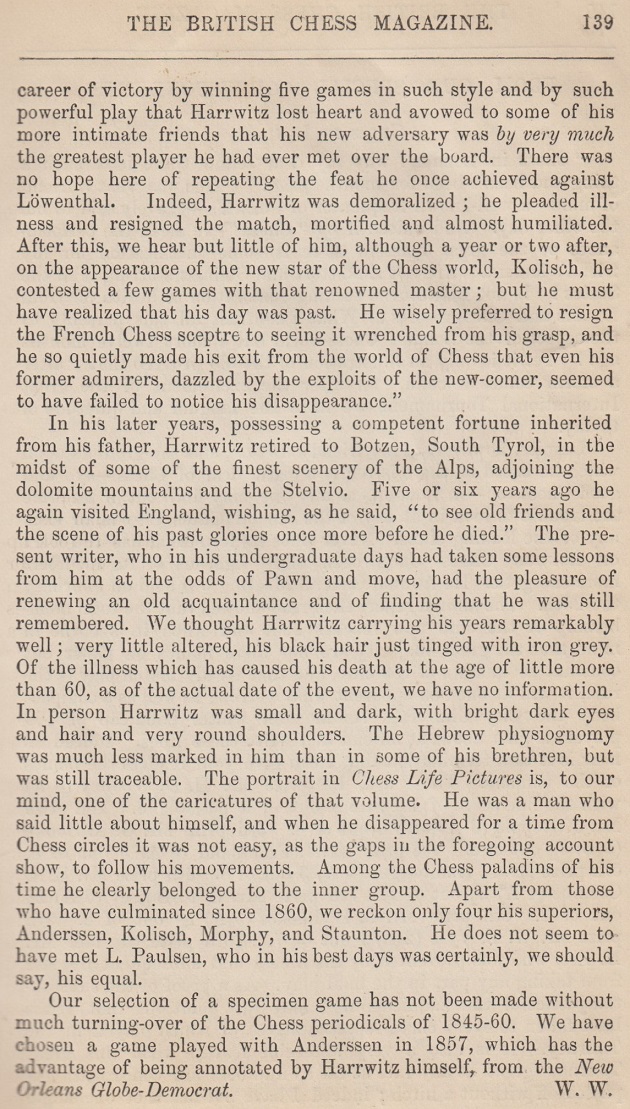
An obviously inaccurate obituary of Harrwitz on page 88 of La Stratégie, 15 March 1884:
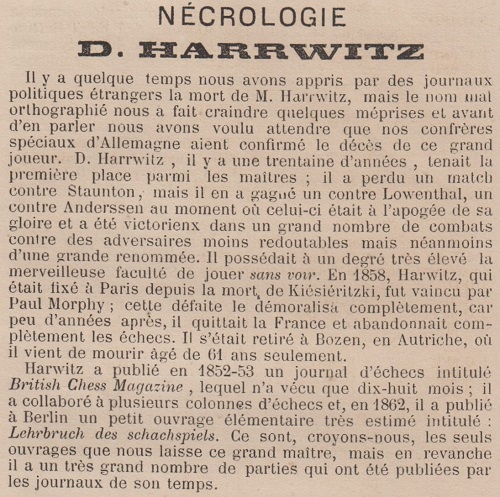
A reader’s reply on pages 182-183 of the 15 June 1884 issue gave some information about Harrwitz’s encounters with Anderssen in Manchester, 1857:
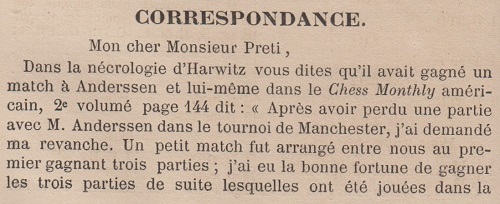
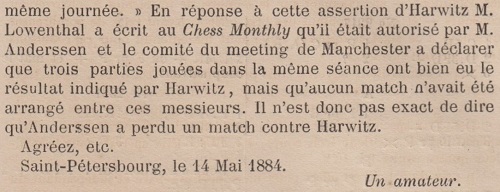
The above Anderssen/Harrwitz matter was presented in the context of these two earlier C.N. items:
Andrés Vicente Sanz (Valencia, Spain) sends this chess column from an unidentified publication (a cutting which he has had for over 30 years) and asks what information is available about the purported victory by Adolf Anderssen over Daniel Harrwitz:
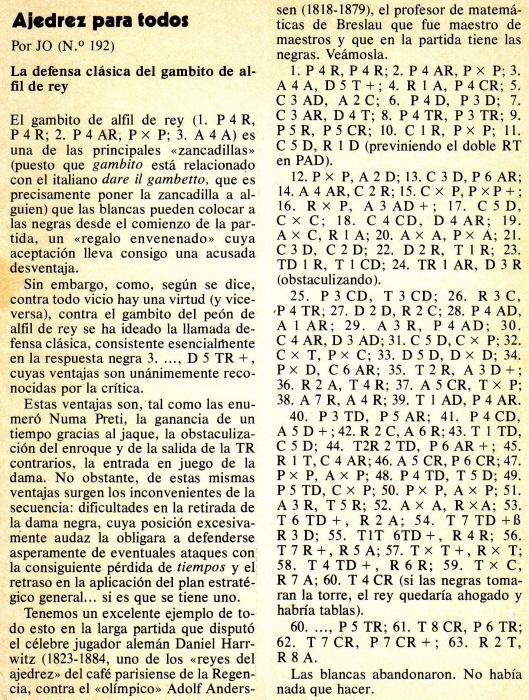
1 e4 e5 2 f4 exf4 3 Bc4 Qh4+ 4 Kf1 g5 5 Nc3 Bg7 6 d4 d6 7 Nf3 Qh5 8 h4 h6 9 e5 g4 10 Ne1 dxe5 11 Nd5 Kd8 12 dxe5 Bd7 13 Nd3 f3 14 Bf4 Ne7
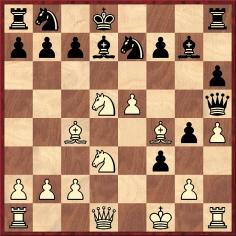
15 Nxc7 fxg2+ 16 Kxg2 Bc6+ 17 Nd5 Nxd5 18 Nb4 Qf5 19 Bxd5 Kc8 Bxc6 bxc6 21 Nd3 Nd7 22 Qe2 Re8 23 Rae1 Rb8 24 Rhf1 Qe6 25 b3 Rb6 26 Kg3 h5 27 Qd2 Kb7 28 c4 Bf8 29 Be3 c5 30 Nf4 Qc6 31 Nd5 Nxe5 32 Nxb6 axb6 33 Qd5 Qxd5 34 cxd5 Nf3 35 Re2 Bd6+ 36 Kf2 Re5 37 Bg5 Rxd5 38 Be7 Be5 39 Rc1 f5 40 a3 f4 41 b4 Bd4+ 42 Kg2 Be3 43 Ra1 Nd4 44 Rea2 f3+ 45 Kh1 Nf5 46 Bg5 g3 47 bxc5 Bxc5 48 a4 Rd4 49 a5 Nxh4 50 axb6 Bxb6 51 Be3 Re4 52 Bxb6 Kxb6 53 Ra6+ Kc7 54 Ra7+ Kd6 55 R1a6+ Ke5 56 Re7+ Kf4 57 Rxe4+ Kxe4 58 Ra4+ Ke3 59 Rxh4 Kf2
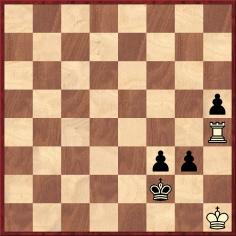
60 Rg4 h4 61 Rg8 h3 62 Rg7 g2+ 63 Kh2 Kf1 64 White resigns.
This is, of course, a further matter requiring wariness.
(6987)
Thomas Niessen (Aachen, Germany) reports that the game is on pages 193-194 of Harrwitz’s Lehrbuch des Schachspiels (Berlin, 1862). The heading is ‘Manchester, 1857’ and, contrary to the claim in the Spanish cutting, Harrwitz was named as Black. In addition to noting the Harrwitz book, Peter Anderberg (Harmstorf, Germany) mentions that the game was published on pages 102-104 of Professor Adolph Anderssen der langjährige Vorkämpfer deutscher Schachmeisterschaft by Ludwig Bachmann (Ansbach, 1914). That work too stated that Anderssen had the white pieces.
Looking further, we have traced the game on pages 142-144 of the May 1858 Chess Monthly. This provides confirmation that Harrwitz was indeed the winner, as Black. The closing note reads:
‘This game was the last of a match played during the Manchester Meeting. Mr Harrwitz says:
“After having lost the game in the tournament to Mr Anderssen I desired my revenge, and although it was not laid down in the Progamme a short match was arranged between us to be decided by the first winner of three games. I had the good fortune to win the three in succession and – an unheard-of thing in England – they were all played at a sitting.”
These games, we believe, have been given in none of the English or German accounts of the meeting. We are indebted for the notes to the distinguished second player.’
(6993)
Another discrepancy involving Harrwitz was discussed in C.N. 3113, and that item (see too page 275 of Chess Facts and Fables) is reproduced here.
The various Morphy monographs consulted by us give the second match-game between Morphy and Harrwitz (Paris, 1858) as follows:
1 e4 e5 2 Nf3 d6 3 d4 exd4 4 Qxd4 Nc6 5 Bb5 Bd7 6 Bxc6 Bxc6 7 Bg5 Nf6 8 Nc3 Be7 9 O-O-O O-O 10 Rhe1 h6 11 Bh4 Ne8 12 Bxe7 Qxe7 13 e5 Bxf3 14 gxf3 Qg5+ 15 Kb1 dxe5 16 Rxe5 Qg2 17 Nd5 Qxh2 18 Ree1 Qd6 19 Rg1 Kh7 20 Qe3 f5 21 Nf4 Qb6 22 Qe2 Rf7 23 Qc4 Qf6 24 Nh5 Qe7 25 Rde1 Qd7 26 a3 Nd6 27 Qd4 Rg8 28 Rg2
28…Ne8 29 Qc3 f4 30 Rh1 g6 31 Rhg1 Qd5 32 Qe1 Qxh5 33 Rg5 Qxf3 34 Qe6 Rf6 35 Qe7+ Rg7 36 Qxe8 hxg5 37 Qe1 Qc6 and wins.
However, we note that Harrwitz himself stated that from the above diagram the game went:
28…b6 29 Reg1 Ne8 30 Qc3 f4 31 Rh1 g6 32 Rhg1 Qd5 33 Qe1 Qxh5 34 Rg5 Qxf3 35 Qe6 Rf6 36 Qe7+ Rg7 37 Qxe8 hxg5 38 Qe1 Qc6 39 f3 Re6 40 Qf2 Rge7 and wins.
Source: Lehrbuch des Schachspiels by D. Harrwitz (Berlin, 1862), page 107.
Staunton also gave this latter version of the game-score in his Illustrated London News column of 2 October 1858.
Some images are added now, beginning with Staunton’s column (page 317):
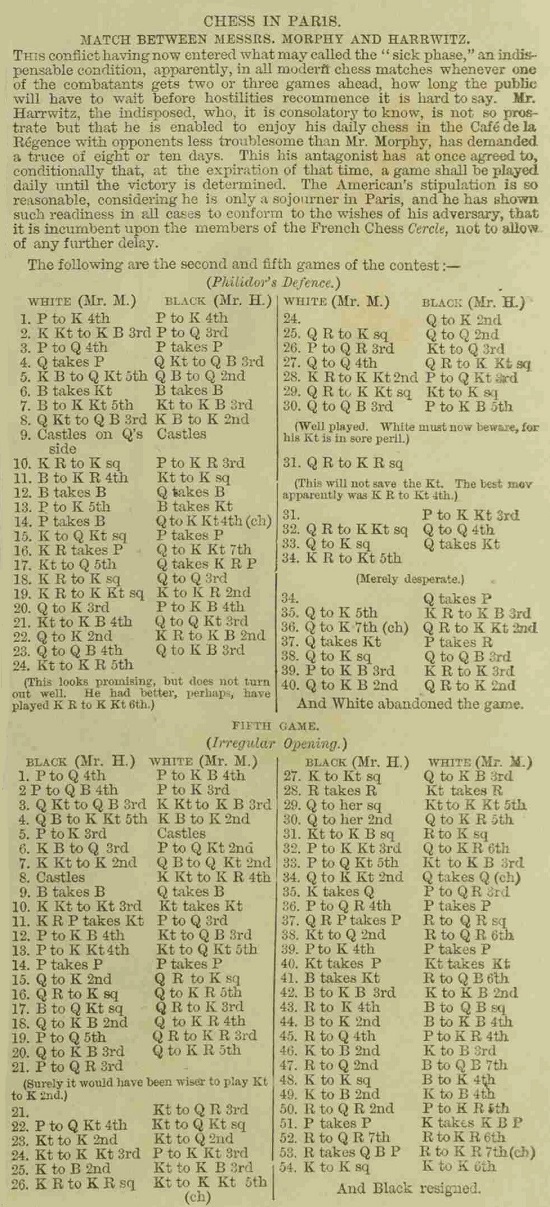
As noted above, that series of moves corresponded to what Harrwitz published four years later:
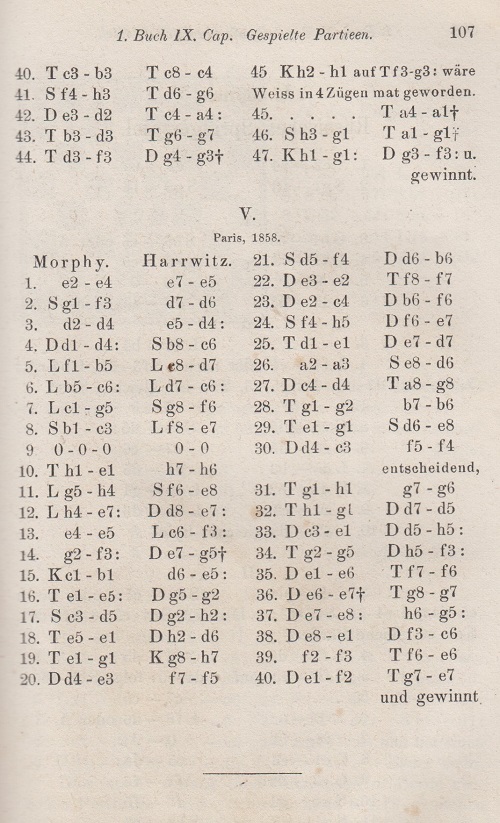
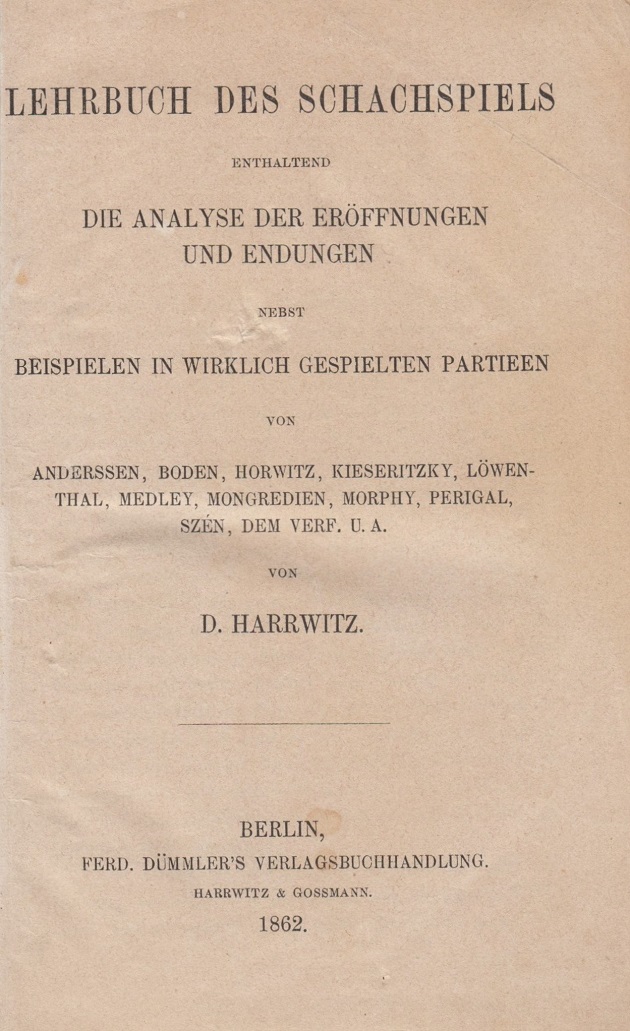
The game-score as published in various Morphy monographs (i.e. 28...Ne8, and not 28...b6) was on page 5 of the Era, 19 September 1858, ‘courtesy of Mr Morphy and Mr Edge’:
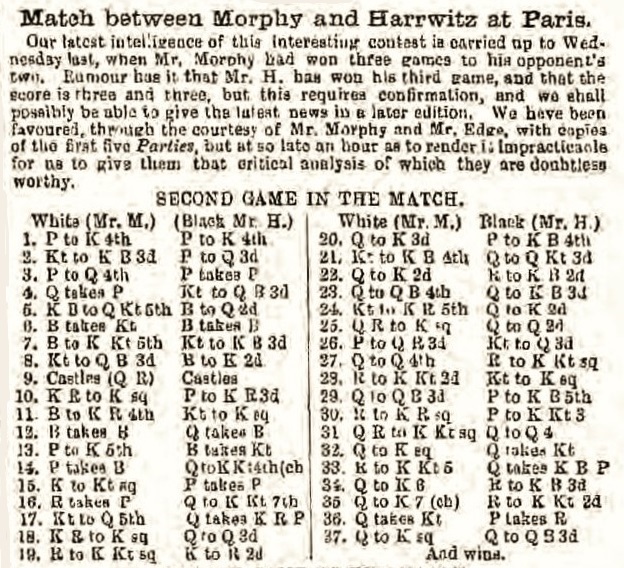
It was also on pages 334-335 of the November 1858 Chess Monthly:
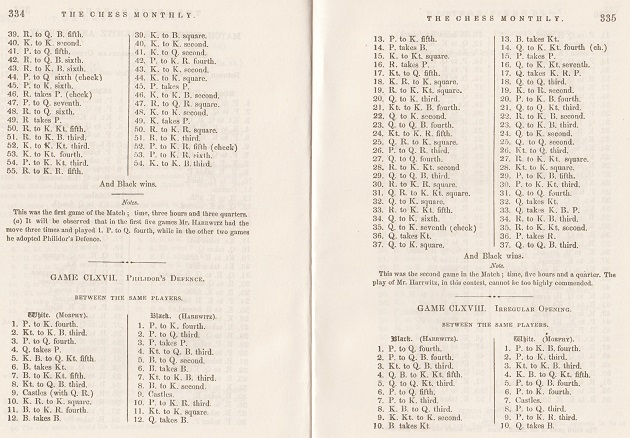
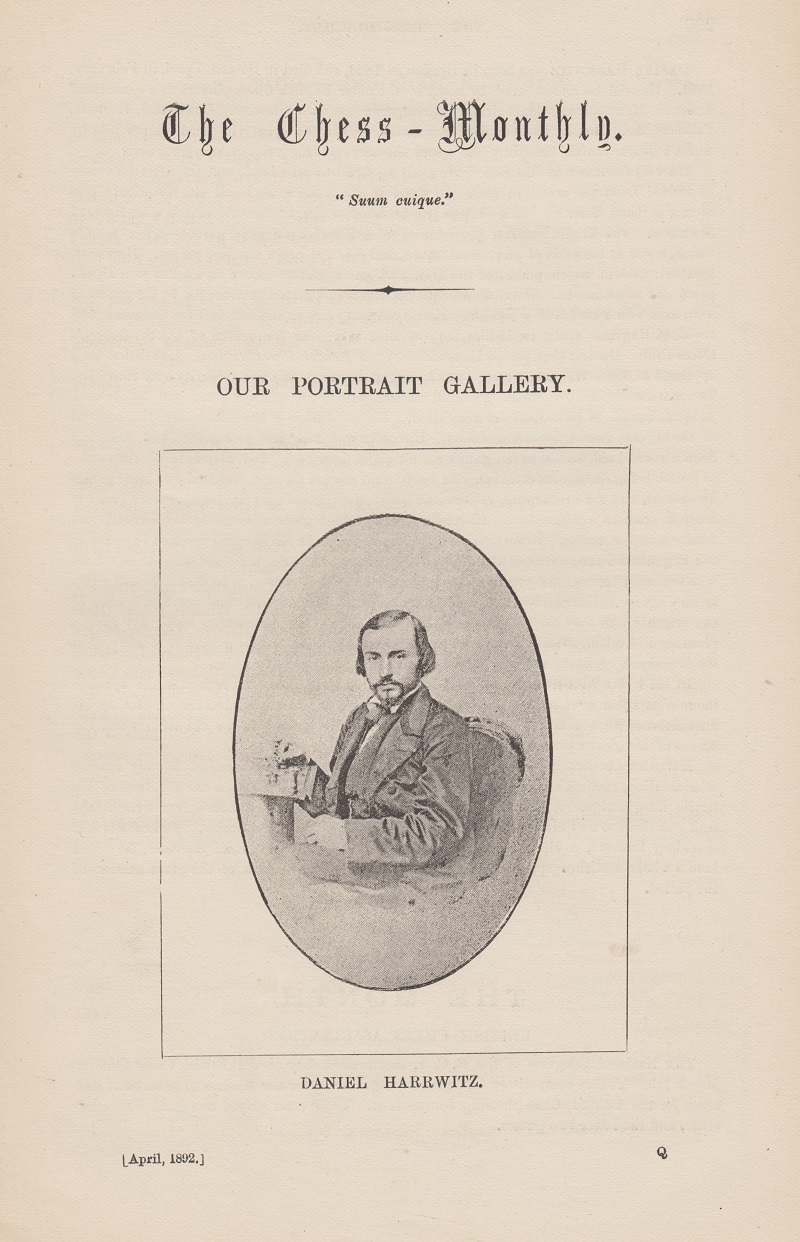
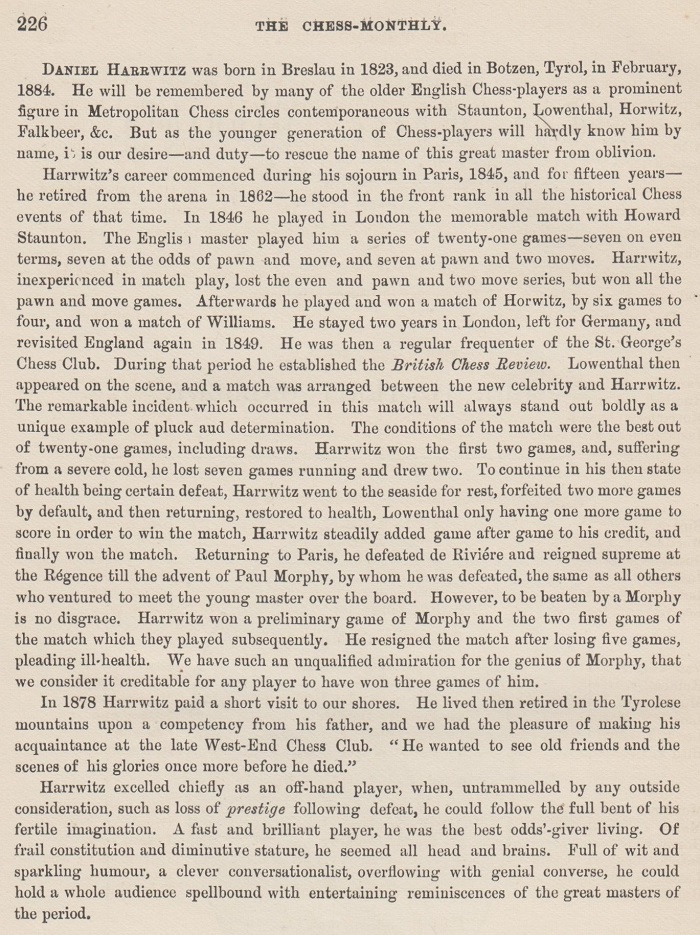
There follows a selection of earlier C.N. items on Harrwitz:
C.N. 3301 noted that the position below appeared (labelled ‘D. Harrwitz Date? Before 1858’) on page 430 of the November 1913 issue of La Stratégie:
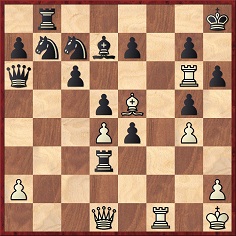
White, to move and win: 1 Rxg7 Rxd1 2 Rxe7+ Kg8 3 Rg7+ Kh8 4 Rxd7+ Kg8 5 Rg7+ Kh8 6 Rxc7+ Kg8 7 Rg7+ Kh8 8 Rxb7+ Kg8 9 Rxb8+ Kh7 10 Rh8+ Kg6 11 Rg8+ Kh7+ 12 Rg7+ Kh8 13 Rxg5+ Kh7 14 Rg7+ Kh8 15 Rxa7+ Kg8 16 Rxa6 Rxf1+ 17 Kg2.
What more is known about this specimen of the windmill/seesaw manoeuvre?
C.N. 4843 noted that on pages 240-245 of the July 1883 BCM W.N. Potter reviewed Chess Life-Pictures by G.A. MacDonnell (London, 1883), and C.N. 4844 quoted, from page 243, Potter’s view of Harrwitz, as prompted by MacDonnell’s book:
‘What the author has to say about Harrwitz is particularly interesting. Some of the best writing in the book is contained in this sketch; and yet there is an after feeling of dissatisfaction. Notwithstanding all that is said we do not seem to understand what kind of man he was. No blame can be imputed to the writer. Harrwitz was evidently not one to disclose his inner self. I met him once or twice four or five years back when he emerged from the Tyrol to revisit London and rather liked him. I had formed of him the notion that he had a metallic character, with the glitter and the hardness. He did not answer to this conception. It speaks well for him that he has retired from the world to woo Nature in the Tyrolese mountains, and I suppose she is nowhere lovelier. This may have softened him, and perhaps he was never really the bright steel sword that he seemed.’
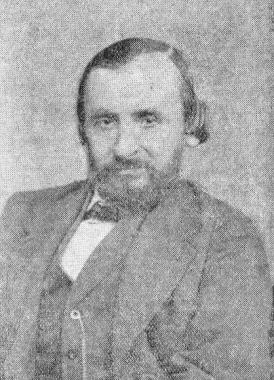
This picture of Daniel Harrwitz is taken from page 269 of volume two of Aus Vergangenen Zeiten by Ludwig Bachmann (Berlin, 1920-22). Does any reader know of a better copy?
Below are two sample chess columns by Harrwitz, from pages 60 and 179 of the first quarterly volume of The Family Friend. The columns are not dated, but the tome’s Preface ends ‘London, 24 September 1852’.
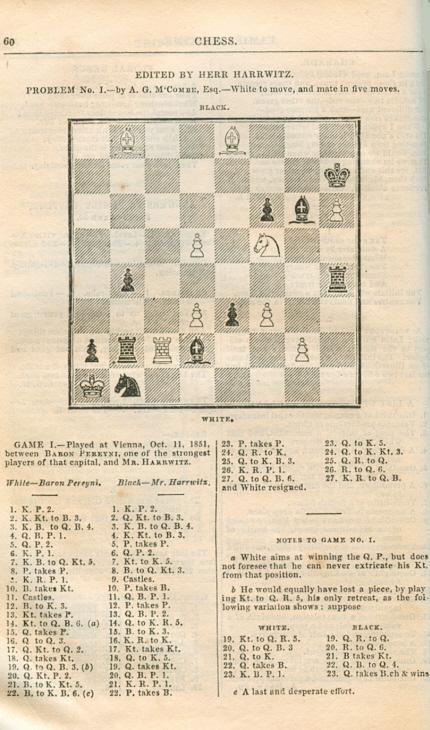
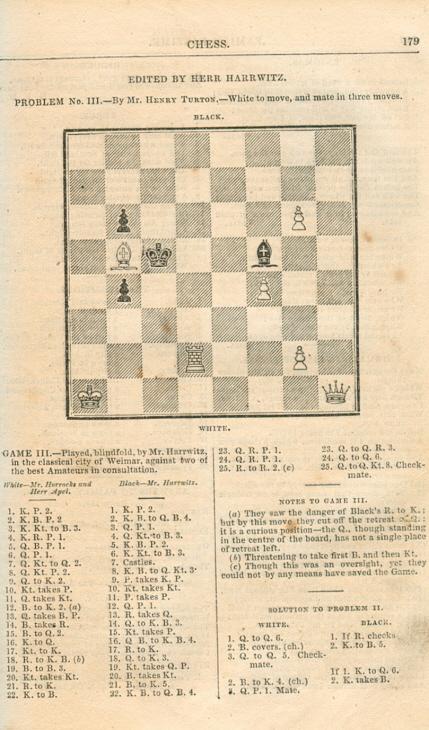
A position from the sixth match-game between Morphy and Harrwitz, Paris, 1858:
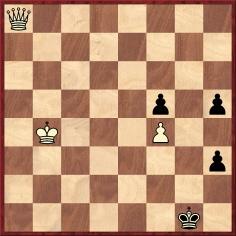
The finish – as given, for instance, on page 61 of Morphy’s Games of Chess by J. Löwenthal (London, 1860) – was 48 Qf3 and wins (‘for if 48...h2 49 Qg3+ Kh1 50 Qf2, mating next move’).
The conclusion was featured in an article ‘Some Historic Blunders’ by W.H. Watts on page 26 of a book co-written by him with A.W. Foster, The Year-Book of Chess 1915 and 1916 (London, 1917):
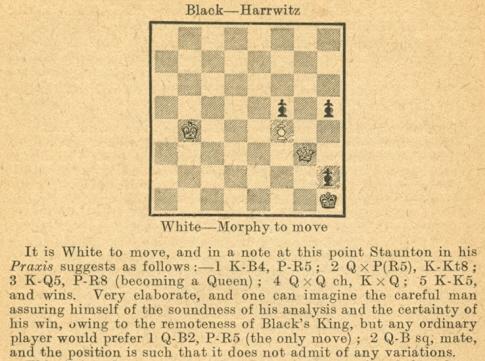
Page 480 of Staunton’s Chess Praxis (London, 1860) stated that after 48 Qf3 Black resigned, and the faulty line referred to by Watts was given in a footnote:
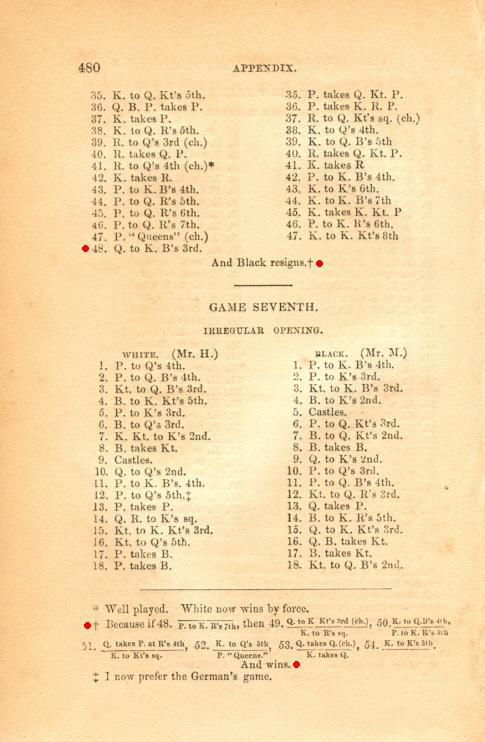
The matter is surprisingly complex, and we would make a number of points:
1) In Chess Praxis the game appeared in a lengthy ‘Appendix’ (pages 453-620) consisting of annotated Morphy games, and we are puzzled by a comment in a review of the book on pages 97-103 of the Chess Player’s Chronicle, 1860:
‘The third and last part of the book is called the Appendix, and consists of the well-known Morphy games to the number of about 150. These games are prefaced by a few lines which lead us to infer that the work was done by contract – so much for so much. The author says: “The notes to the games in the Appendix are generally taken from the publications in which they at first appeared, and are generally good, although we cannot always approve of the taste which prevailed in the choice of them.[”]’
That is a strange remark for any author to make, but in any case we cannot find the passage in our (1860) edition of Chess Praxis.
2) Staunton published the erroneous analysis in his Illustrated London News column of 9 October 1858 (page 344). We thank Rod Edwards (Victoria, BC, Canada) for a copy:
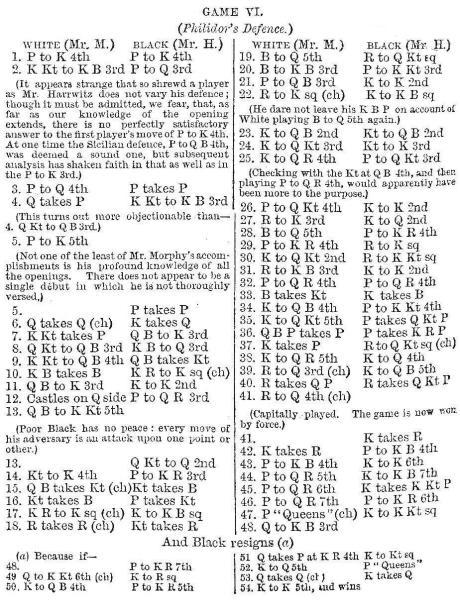
On page 340 of the November 1858 Chess Monthly the analysis by Staunton was repeated (without any indication that it was wrong):
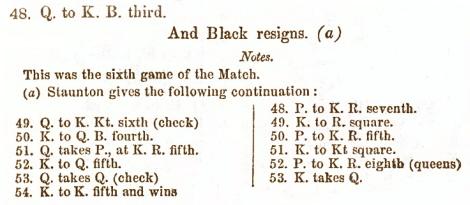
The same text, and still with notation errors, was reproduced on page 36 of Morphy’s Games of Chess, and Frère’s Problem Tournament by T. Frère (New York, 1859):
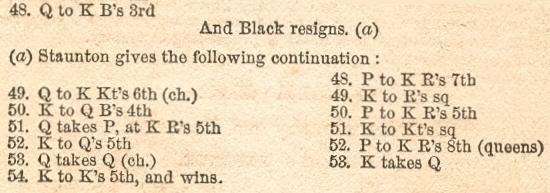
3) The line was given too, without any mention of Staunton, on page 241 of Paul Morphy, A Sketch from the Chess World by Max Lange (London, 1860):
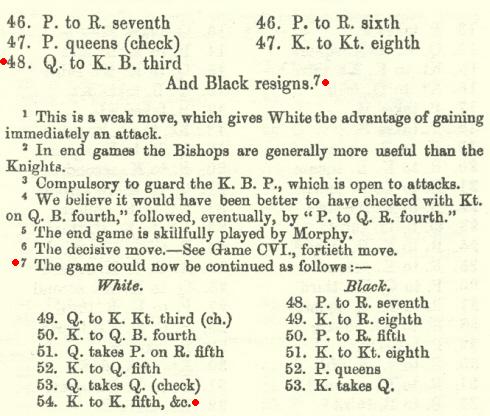
4) Page 109 of Choix des parties les plus remarquables jouées par Paul Morphy en Amérique, en Angleterre et en France by J. Preti (Paris, 1859) gave the same moves but indicated that they were played over the board:
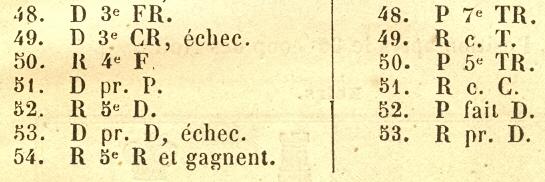
If the Preti book were correct, it would mean that, in the diagrammed position below, Morphy too missed 50 Qf2 and 51 Qf1 mate, during the game.
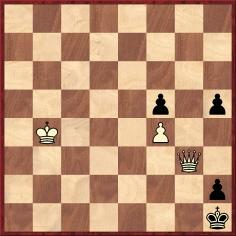
There is surely much more to be discovered about this matter.
The missed mate in two was discussed on pages 196-197 of a book by W. Ritson Morry and W. Melville Mitchell, who unpersuasively concluded:
‘How could two such writers [Max Lange and Howard Staunton] miss the simple mate? One can only suppose the players themselves indicated the line after the game and nobody bothered to check.’
The book appeared in the 1960s and 1970s under a slew of titles: Chess: A Way to Learn; Chess The Elements and the Play; Tackle Chess This Way; Tackle Chess; Chess Theory and Practice.
‘I wonder whether it is a very old story – that puzzle by (I believe) J.H. Blackburne. Place the black K on one of the four central squares, and then take from the box two white rooks and one white knight. Now arrange these three white pieces so that the black K stands mated. No moves are to be made – simply place them in such a manner that the condition is fulfilled. As there are no pawns, there is necessarily more than one solution, but the principle is the same in each. If you do it in 15 minutes you will be smarter than I was.’
This problem was set by P.H. Williams. The source will be given in a future C.N. item, together with the solution (which, perhaps understandably, was rather hidden away by Williams).
(9930)
The problem in C.N. 9930 was given by P.H. Williams under the heading ‘Ingenious Puzzle’ on page 280 of the Chess Amateur, June 1909. In the ‘Answers to Correspondents’ section on page 345 of his August 1909 column he wrote:
‘A. Mendes da Costa: White’s Rs at Q5 and KB5, Kt at KKt5; Black K at K4 – an impossible position, of course, but mate.’
As noted by Michael McDowell (Westcliff-on-sea, England), the composition is on page 52 of Sam Loyd and His Chess Problems by Alain C. White (Leeds, 1913):
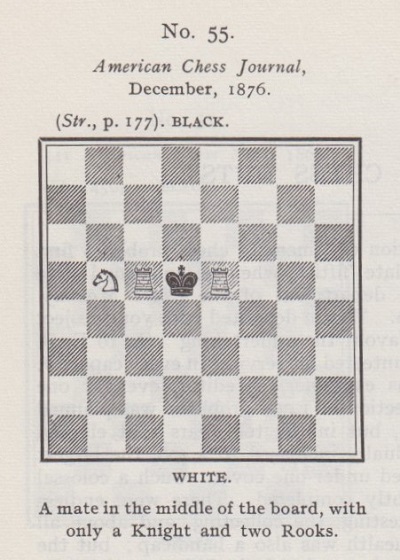
Our correspondent also points out White’s comment about Loyd on page 53:
‘His wood-cuts in the American Chess Journal testify to his skill in this most difficult branch of work. There was often a whimsical characteristic concealed in his engravings. I remember the one of Harrwitz, excellently done; but if one looks closely at the board before him, at which Harrwitz is looking with serious consideration, one finds that Loyd has depicted on it that absurd position shown in No. 55.’
The illustration (based on the photograph in C.N. 6286) was published at the end of the December 1878 edition of the American Chess Journal:
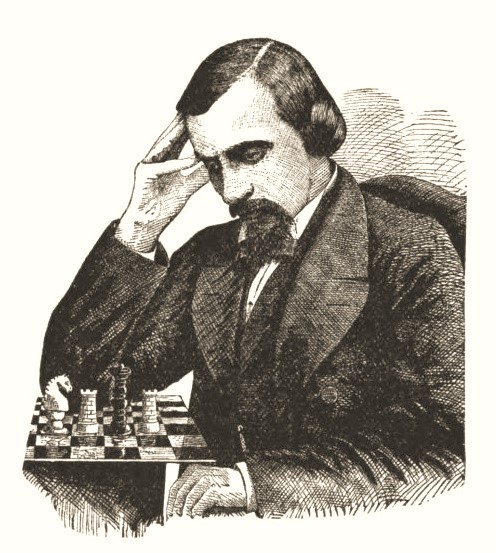
Below is the picture’s earlier appearance, on page 1566 of the Scientific American Supplement, 17 November 1877:
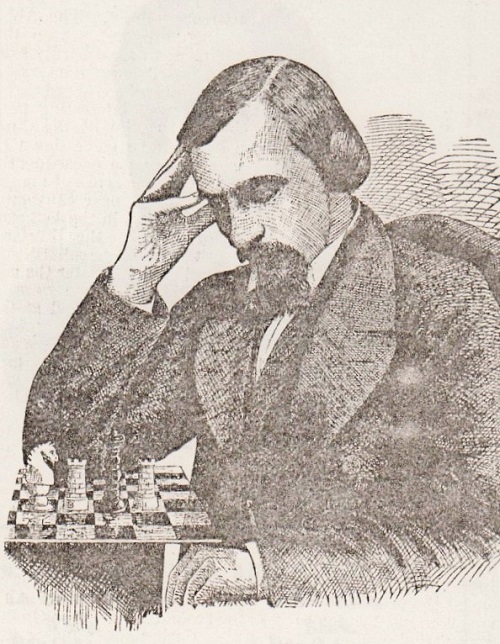
Regarding the book extract above, the date in the reference ‘American Chess Journal, December 1876’ is not, as might be imagined, an error for December 1878. Both issues of the periodical had material on the position.
Page 112 of the December 1876 edition:
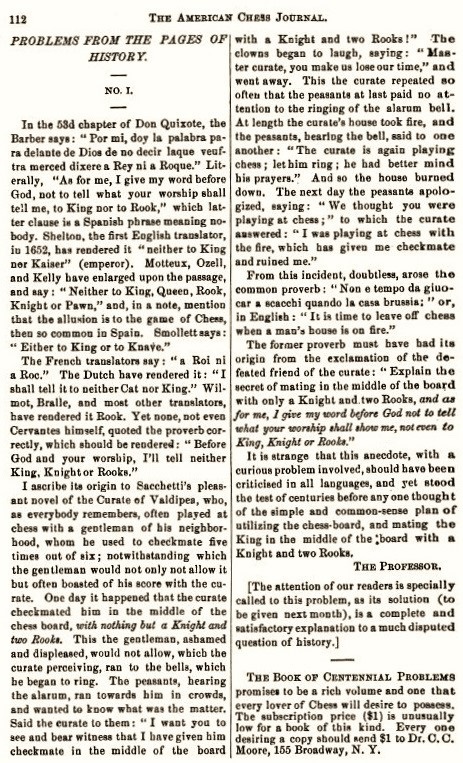
The solution was published on pages 124-125 of the January 1877 issue:
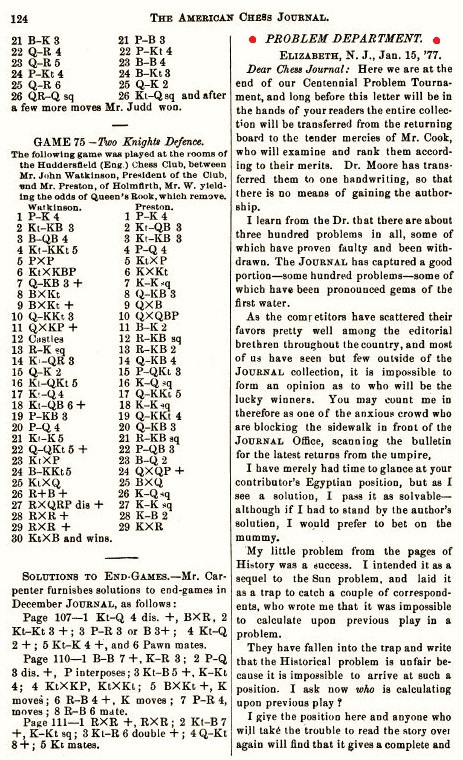
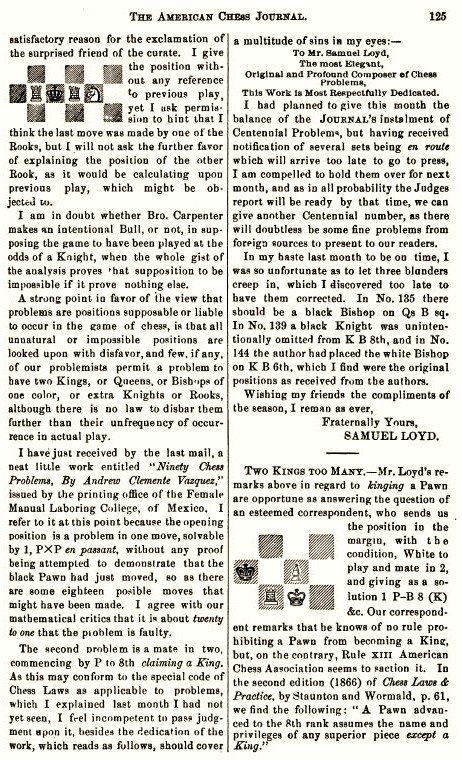
Finally, the reference ‘Str., p. 177’ in A.C. White’s book is to Loyd’s volume Chess Strategy (Elizabeth, 1878). The full page:
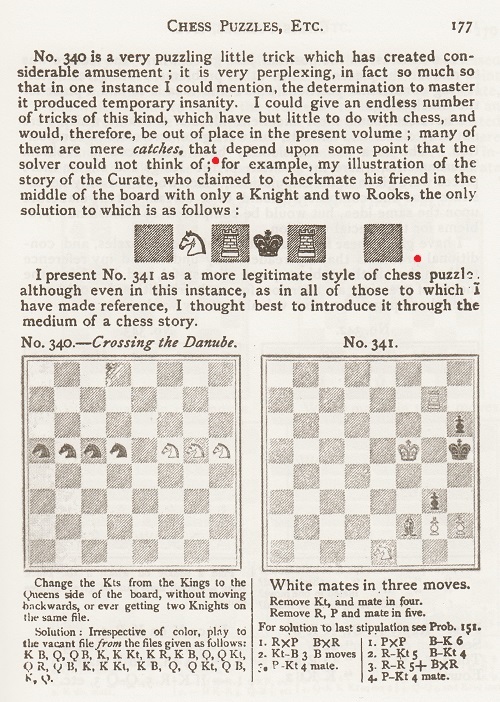
Information is sought on the photograph of Harrwitz given in C.N. 6286 (i.e. at the start of the present feature article). It appeared on page 129 of David Lawson’s monograph on Morphy with the caption ‘David Harrwitz’, a mistake which Lawson noted in a small errata sheet (C.N. 5672).
A number of items (see, for instance, Attacks on Howard Staunton) have quoted, sans parti pris, criticism of Staunton’s intellectual honesty.
An addition from pages 381-382 of Daniel Harrwitz’s British Chess Review, 1853:
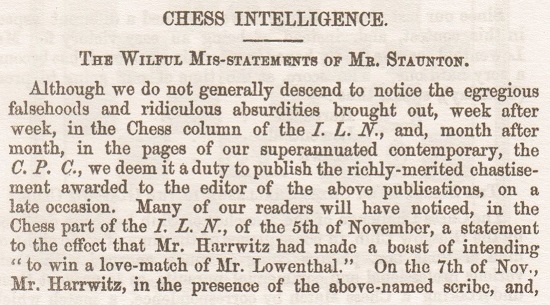
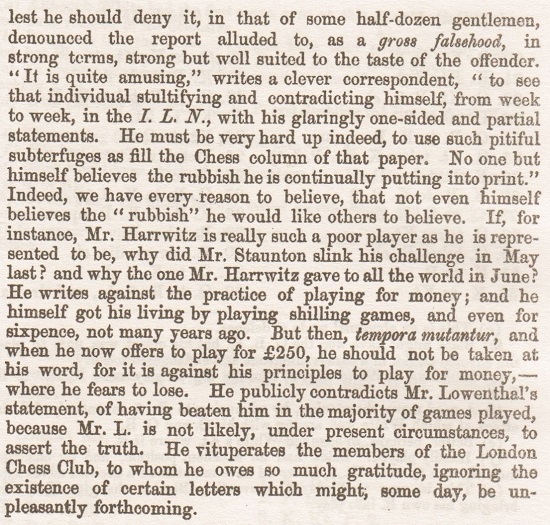
Below is the relevant part of the Illustrated London News column referred to (5 November 1853, page 383):
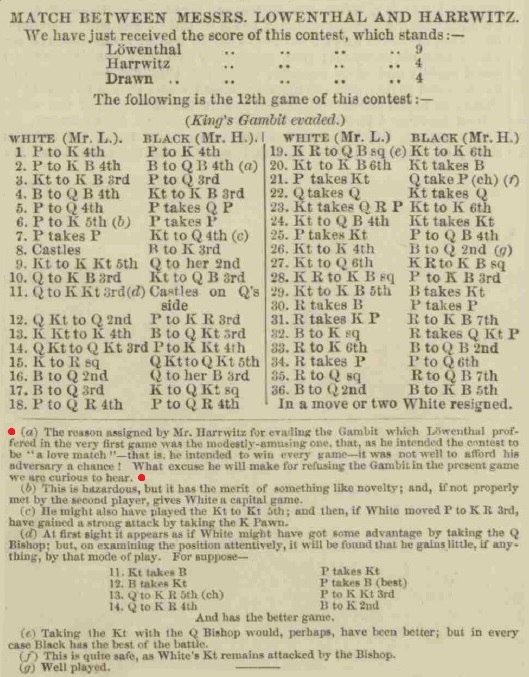
From earlier in the same column a response by Staunton to ‘Pedagogus’ is notable:
‘You must not estimate a man’s intellectual power by his skill at chess. Some of the ablest men we have known play chess, in spite of great application, very indifferently; while many blockheads we have met with play very well.’
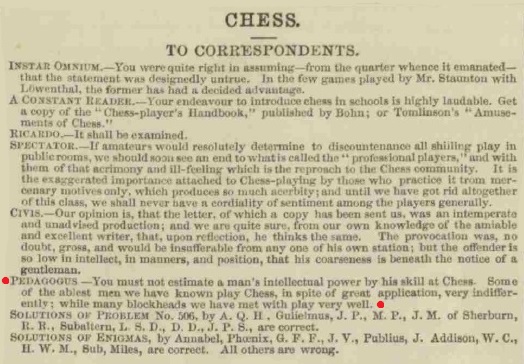
From John Townsend (Wokingham, England):
‘The 1853 British Chess Review article reproduced in C.N. 11319 contains expressions such as “egregious falsehoods”, “ridiculous absurdities” and “rubbish”, all directed at Howard Staunton. One might expect that such truculent language would be accompanied by suitable substantiation, yet in the few examples discussed only a small amount of evidence was proffered, and it looks far from convincing.
Staunton is accused of a “gross falsehood” regarding his remark that Harrwitz intended “a love match” against Löwenthal. However, that Harrwitz did say something similar was later affirmed by Charles Tomlinson, a scientific writer and lecturer whose recollection of the controversy appeared on pages 50-51 of the BCM, February 1891, in an article about Simpson’s Divan:
“Harrwitz was so elated at having won the first two games that he declared in my presence that Löwenthal should not win a single game.”
Later Tomlinson witnessed a confrontation in Spring Gardens when Harrwitz denied the boast, whereupon both Staunton and Tomlinson were silent:
“Staunton simply smiled, and said nothing. Of course I was equally silent, from a reluctance to get into hot water with the Divan party.”
Tomlinson’s account implies that he could have rebutted Harrwitz’s accusation.
The accusation “slink his challenge” is used in connection with the abortive negotiations in 1853 for a Staunton-Harrwitz match, but that seems a biased summary of what took place. In an address to the Northern and Midland Counties Chess Association at its Manchester meeting in 1853 (see the Chess Player’s Chronicle, 1854, pages 187-189), Staunton explained at some length his reluctance to accept Harrwitz’s challenge, observing, in particular, that he had previously beaten him in a match and that the opponent whom he was really seeking was Adolf Anderssen. Nevertheless, negotiations did eventually get underway, but later broke down, after which a letter from Edgar Sheppard, Staunton’s second, which was published on page 61 of the Illustrated London News, 21 January 1854 gave the impression that Harrwitz’s side had defaulted and forfeited the £25 deposit “by the articles of agreement”.
Staunton’s attitude towards playing for money appears to have changed with time, and he is criticized for that. Nonetheless, in the case of an important match a worthwhile stake was customary, and it is arguable that he was justified in seeking one for a match with Harrwitz in which he had little to prove, having previously defeated him decisively.
The article supports Löwenthal’s side of the argument over the disputed Staunton v Löwenthal score but, in the absence of any evidence to explain the reasoning, is the comment really worth anything?
The final sentence contains a mysterious threat regarding “the existence of certain letters”, presumably containing some compromising information about Staunton. However, the letters have not so far been “unpleasantly forthcoming”, despite the passage of 166 years. Without them the remark seems no better than tittle-tattle.
The editor of the British Chess Review was Daniel Harrwitz, but was he solely responsible for this article? It is questionable whether someone whose native tongue was not English could have produced the article without help. Tim Harding discussed the involvement of Samuel Standidge Boden with the British Chess Review on pages 130-132 of his book British Chess Literature to 1914 (Jefferson, 2018).’
C.N. 11319 showed extracts from Staunton’s Illustrated London News column of 5 November 1853, page 383, concerning the Harrwitz v Löwenthal match. An addition comes from page 427 of the 19 November 1853 issue:
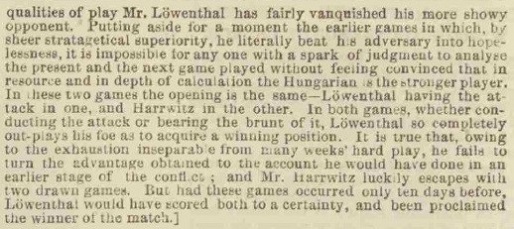
A response to both columns appeared on the cover of the December 1853 edition of Harrwitz’s British Chess Review:
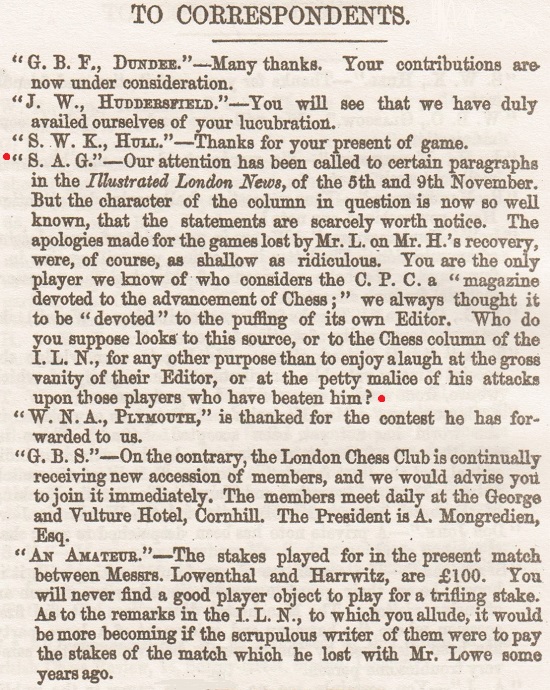
A plate in F.M. Edge’s 1859 monograph on Paul Morphy:
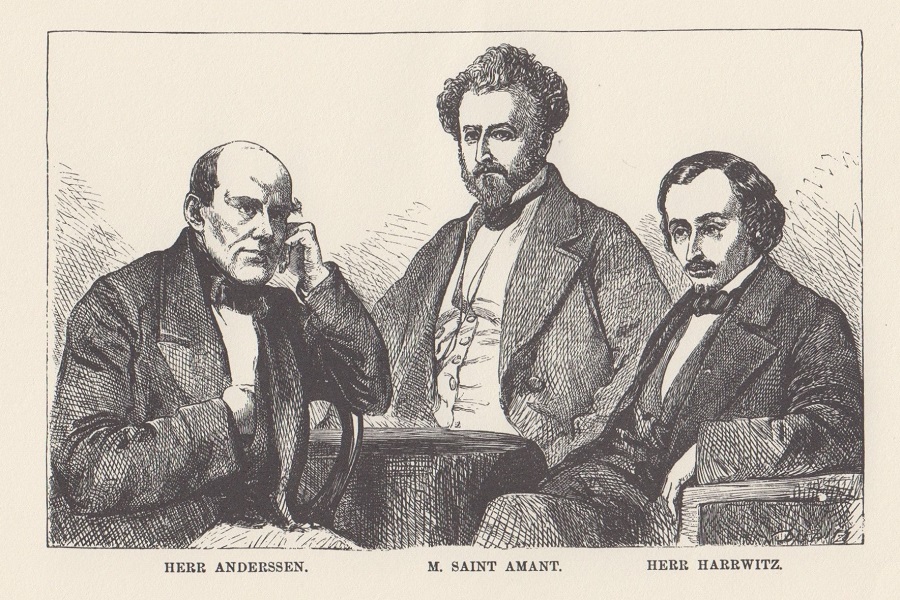
An entry in Retirement from Chess:
In a letter sent from London on 23 July 1854 (i.e. four years before his match with Morphy) Harrwitz wrote:
‘Chess, if it has not been otherwise profitable, has procured me many a dear friend, but now my career is closed – I have ascended the ladder, and will not condescend to redescend it – so I give up chess altogether, go home and settle down into obscurity, which, if less conducive to renown and glory, is a great deal more so to health. When ambition is satisfied we look for something more solid and enduring. After years of indisposition and labour, I have at last discovered that I am “paying too much for my whistle”.’
Source: BCM, May 1884, page 182.
From C.N. 2593:
As noted by W.H. Cozens on page 402 of the September 1978 BCM (in connection with The Encyclopedia of Chess by H. Golombek), chess reference books do not agree on whether raking bishops should be named after Harrwitz or Horwitz. A detailed article on the subject, by Peter Gütler, is on pages 42-43 of Kaissiber, April-June 1999.
For further information, see Raking Bishops.
To the Chess Notes main page.
To the Archives for other feature articles.
Copyright: Edward Winter. All rights reserved.